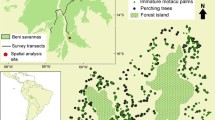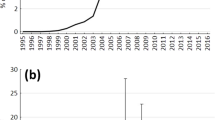Abstract
Many carnivorous mammals consume fruits and disperse the intact seeds to specific sites. Few studies have attempted to quantify this seed dispersal or evaluate its effectiveness, despite its potential importance and functional uniqueness. In the study reported here, we found that a frugivorous carnivore, the common palm civet (Paradoxurus hermaphroditus), generated seed shadows that are distinct from those of the sympatric frugivore, the pig-tailed macaque (Macaca nemestrina), and played a unique and important role in the regeneration of Leea aculeata (Leeaceae). We found that macaques dispersed the seeds randomly, while civets dispersed them non-randomly to sites such as the banks of small rivers, rain-flow paths, abandoned trails, and treefall gaps, which are characterized by low stem density and canopy cover. Seeds of L. aculeata that were dispersed by civets to the banks of rivers and gaps had significantly higher survival and growth rates than those dispersed to rain-flow paths or abandoned trails. Seeds dispersed by macaques or to random locations also had low survival. Although the effects of the civets on seed fate were not straightforward, compared with macaques and random dispersal, civets significantly enhanced the survival and growth of L. aculeata seeds after 1 year. These results indicate that non-random dispersal by civets is important for the persistence of L. aculeata. Civets may disperse other plant species and thus could have profound effects on forest dynamics.


Similar content being viewed by others
References
Bartels E (1963) On Paradoxurus hermaphroditus javanicus (Horsfield, 1824) the common palm civet or tody cat in Western Java. Notes on its food and feeding habitats. Its ecological importance for wood and rural biotopes. Beaufortia 124:193–201
Bates D, Sarkar D (2008) lme4: linear mixed-effects models using S4 classes. Available at: http://cran.r-project.org/web/packages/lme4/index.html
Bearder SK, Randall RM (1978) The use of fecal marking sites by spotted hyenas and civets. Carnivore 1:32–48
Briggs JS, Wall SBV, Jenkins SH (2009) Forest rodents provide directed dispersal of Jeffrey pine seeds. Ecology 90:675–687
Brodie JF, Helmy OE, Brockelman WY, Maron JL (2009) Functional differences within a guild of tropical mammalian frugivores. Ecology 90:688–698
Broström G, Broström MG (2009) Package ‘glmmML’. Available at: http://cran.r-project.org/web/packages/glmmML/index.html
Bustamante RO, Simonetti JA, Mella JE (1992) Are foxes legitimate and efficient seed dispersers? A field test. Acta Oecol 13:203–208
Capurro AF, Novaro AJ, Travaini A, Romero MS (1997) Improved bile-acid thin-layer chromatography to identify feces of neotropical carnivores. J Wildl Manage 61:1424–1427
Corlett RT (1998) Frugivory and seed dispersal by vertebrates in the Oriental (Indomalayan) Region. Biol Rev 73:413–448
Corlett RT (2002) Frugivory and seed dispersal in degraded tropical East Asian landscapes. In: Levey D, Silva W, Galetti M (eds) Seed dispersal and frugivory: ecology, evolution and conservation. CABI Publ, New York, pp 451–465
Dean WRJ, Milton SJ (2000) Directed dispersal of Opuntia species in the Karoo, South Africa: are crows the responsible agents? J Arid Env 45:305–314
Dudgeon D, Corlett RT (1994) Hills and streams: an ecology of Hong Kong. Hong Kong University Press, Hong Kong
Engel TR (2000) Seed dispersal and forest regeneration in a tropical lowland biocoenosis (Shimba Hills, Kenya). PhD thesis. University of Bayreuth, Germany
ESRI (2000) ArcView GIS. Version 3.2. Systems Research Institute, Redlands
Espirito-Santo C, Rosalino LM, Santos-Reis M (2007) Factors affecting the placement of common genet latrine sites in a Mediterranean landscape in Portugal. J Mammal 88:201–207
Fedriani JM, Delibes M (2009) Seed dispersal in the Iberian pear, Pyrus bourgaeana: a role for infrequent mutualists. Ecoscience 16:311–321
Forget PM, Milleron T (1991) Evidence for secondary seed dispersal by rodents in Panama. Oecologia 87:596–599
Gorman ML, Trowbridge BJ (1989) The role of odor in the social lives of carnivores. In: Gittleman JL (ed) Carnivore behavior, ecology, and evolution. Cornell University Press, Ithaca, pp 57–88
Grime JP (2002) Plant strategies, vegetation processes, and ecosystem properties. Wiley, West Sussex
Gross-Camp N, Kaplin BA (2005) Chimpanzee (Pan troglodytes) seed dispersal in an afromontane forest: microhabitat influences on the postdispersal fate of large seeds. Biotropica 37:641–649
Herrera CM (1989) Frugivory and seed dispersal by carnivorous mammals, and associated fruit characteristics, in undisturbed Mediterranean habitats. Oikos 55:250–262
Hutchings MR, White PCL (2000) Mustelid scent-marking in managed ecosystems: implications for population management. Mammal Rev 30:157–169
Ikeda H (1984) Raccoon dog scent marking by scats and its significance in social behaviour. J Ethol 2:77–84
Jordano P, Schupp EW (2000) Seed disperser effectiveness: the quantity component and patterns of seed rain for Prunus mahaleb. Ecol Monogr 70:591–615
Jordano P, Garcia C, Godoy JA, Garcia-Castano JL (2007) Differential contribution of frugivores to complex seed dispersal patterns. Proc Natl Acad Sci USA 104:3278–3282
Joshi AR, Smith JLD, Cuthbert FJ (1995) Influence of food distribution and predation pressure on spacing behavior in palm civets. J Mammal 76:1205–1212
Kleiman DG (1966) Scent-marking in the Canidae. Symp Zool Soc Lond 18:167–173
Koike S, Morimoto H, Goto Y, Kozakai C, Yamazaki K (2008) Frugivory of carnivores and seed dispersal of fleshy fruits in cool-temperate deciduous forests. J For Res 13:215–222
Levine JM, Murrell DJ (2003) The community-level consequences of seed dispersal patterns. Annu Rev Ecol Syst 34:549–574
Loiselle BA, Blake JG (1999) Dispersal of melastome seeds by fruit-eating birds of tropical forest understory. Ecology 80:330–336
Martinez I, Garcia D, Obeso JR (2008) Differential seed dispersal patterns generated by a common assemblage of vertebrate frugivores in three fleshy-fruited trees. Ecoscience 15:189–199
Mitchell AH (1994) Ecology of Hose’s langur (Presbytis hosei) in logged and unlogged Dipterocarp forest of northeast Borneo. PhD thesis. Yale University, New Haven
Mudappa D (2001) Ecology of the brown palm civet Paradoxurus jerdoni in the tropical rainforests of the Western Ghats, India. PhD thesis. Bharathiar University, Coimbatore
Nakashima Y, Jumrafiah AS (2010) Importance of common palm civets (Paradoxurus hermaphroditus) as a long-distance disperser for large-seeded plants in degraded forests. Tropics (in press)
Nakashima Y, Inoue E, Inoue-Murayama M, Jumrafiha AS (2010) High potential of a disturbance-tolerant frugivore, the common palm civet Paradoxurus hermaphroditus (Viverridae), as a seed disperser for large-seeded plants. Mammal Stud (in press)
Nathan R, Muller-Landau HC (2000) Spatial patterns of seed dispersal, their determinants and consequences for recruitment. Tren Ecol Evol 15:278–285
Onoguchi (2009) Assessment of physiological stress of logging on wildlife in Bornean tropical forest. MSc thesis. Kyoto University, Kyoto
Page LK, Swihart RK, Kazacos KR (1998) Raccoon latrine structure and its potential role in transmission of Baylisascaris procyonis to vertebrates. Am Midi Nat 140:180–185
Pearson KM, Theimer TC (2004) Seed-caching responses to substrate and rock cover by two Peromyscus species: implications for pinyon pine establishment. Oecologia 141:76–83
Petersen JH (1998) An additive frailty model for correlated life times. Biometrics 54:646–661
Pinheiro JC, Bates DM (2000) Mixed-effects models in S and S-PLUS. Springer, New York
Prugh LR, Ritland CE (2005) Molecular testing of observer identification of carnivore feces in the field. Wildl Soc Bull 33:189–194
R Development Core Team (2008) R: language and environment for statistical computing. R Foundation for Statistical computing, Vienna. Available at: http://cran.r-project.org/
Rabinowitz AR (1991) Behaviour and movements of sympatric civet species in Huai Kha Khaeng Wildlife Sanctuary, Thailand. J Zool 223:281–298
Ralls K (1971) Mammalian scent marking. Science 171:443–449
Roper TJ, Conradt L, Butler J, Christian SE, Ostler J, Schmid TK (1993) Territorial marking with faeces in badgers (Meles meles): a comparison of boundary and hinterland latrine use. Behaviour 127:289–307
Rozhnov VV, Rozhnov YV (2003) Roles of different types of excretions in mediated communication by scent marks of the Common palm civet, Paradoxurus hermaphroditus Pallas, 1777 (Mammalia, Carnivora). Biol Bull 30:584–590
Russo SE, Portnoy S, Augspurger CK (2006) Incorporating animal behavior into seed dispersal models: Implications for seed shadows. Ecology 87:3160–3174
Schabacker J, Curio E (2000) Fruit characteristics as determinants of gut passage in a bulbul (Hypsipetes philippinus). Ecotropica 6:157–168
Silva SI, Bozinovic F, Jaksic FM (2005) Frugivory and seed dispersal by foxes in relation to mammalian prey abundance in a semiarid thornscrub. Austr Ecol 30:739–746
Sokal RR, Rohof FJ (1995) Biometry. The principles and practice of statistics in biological research. W. H. Freeman, San Francisco
Stoner KE, Riba-Hernandez P, Vulinec K, Lambert JE (2007) The role of mammals in creating and modifying seed shadows in tropical forests and some possible consequences of their elimination. Biotropica 39:316–327
Su S, Sale J (2007) Niche differentiation between Common Palm Civet Paradoxurus hermaphroditus and Small Indian Civet Viverricula indica in regeneration degraded forest, Myanmar. Small Carniv Conserv 36:30–34
Tamura K, Dudley J, Nei M, Kumar S (2007) MEGA4: molecular evolutionary genetics analysis (MEGA) software version 4.0. Mol Biol Evol 24:1596
Therneau T, Lumley T (2009) Survival analysis, including penalised likelihood. Available at: http://cran.r-project.org/web/packages/survival/index.html
Thiessen D, Rice M (1976) Mammalian scent gland marking and social behavior. Psychol Bul 83:505–539
Traveset A (1998) Effect of seed passage through vertebrate frugivores’ guts on germination: a review. Perspect Plant Ecol Evol Syst 1:151–190
Veron G, Heard S (2000) Molecular systematics of the Asiatic Viverridae (Carnivora) inferred from mitochondrial cytochrome b sequence analysis. J Zool Syst Evol Res 38:209–217
Wenny DG (2000) Seed dispersal, seed predation, and seedling recruitment of a neotropical montane tree. Ecol Monogr 70:331–351
Wenny DG, Levey DJ (1998) Directed seed dispersal by bellbirds in a tropical cloud forest. Proc Natl Acad Sci USA 95:6204–6207
Westcott DA, Bentrupperbaumer J, Bradford MG, McKeown A (2005) Incorporating patterns of disperser behaviour into models of seed dispersal and its effects on estimated dispersal curves. Oecologia 146:57–67
Willson MF (1993) Mammals as seed-dispersal mutualists in North-America. Oikos 67:159–176
Yasuma S, Andau M (1999) Mammals of Sabah, field guide and identification. Japan International Cooperation Agency and Sabah Wildlife Department, Kota Kinabalu
Yasuma S, Andau M (2000) Mammals of Sabah, Part 2, habitat and ecology. Japan International Cooperation Agency and Sabah Wildlife Department, Kota Kinabalu
Yumoto T, Noma N, Maruhashi T (1998) Cheek-pouch dispersal of seeds by Japanese monkeys (Macaca fuscata yakui) on Yakushima Island, Japan. Primates 39:325–338
Zhou YB, Zhang JS, Slade E, Zhang LB, Palomares F, Chen J, Wang XM, Zhang SY (2008) Dietary shifts in relation to fruit availability among masked palm civets (Paguma larvata) in central China. J Mammal 89:435–447
Acknowledgments
We thank EPU Malaysia and the Sabah Wildlife Department for granting us permission to conduct research in Sabah, Malaysia. We are grateful to Drs. J. Yamagiwa, N. Nakagawa, G. Hanya, H. Matsubayashi, H. Samejima, N. Kuze, and Ms. M. Nakabayashi for their encouragement and suggestions. J. Shykoff and two anonymous referees made useful comments to a previous version of the paper. This research was supported by a Research Fund of the Japan Society for the Promotion of Science, JSPS Research Fellowships for Young Scientists for Y. N. and by the Global COE Program A06 to Kyoto University, and by the Ministry of Education, Culture, Sports, Science and Technology (MEXT) with a Grant-in-Aid for Science Research (B; #21310150 to MI-M). This study complies with the current laws of Malaysia.
Author information
Authors and Affiliations
Corresponding author
Additional information
Communicated by Jacqui Shykoff.
Rights and permissions
About this article
Cite this article
Nakashima, Y., Inoue, E., Inoue-Murayama, M. et al. Functional uniqueness of a small carnivore as seed dispersal agents: a case study of the common palm civets in the Tabin Wildlife Reserve, Sabah, Malaysia. Oecologia 164, 721–730 (2010). https://doi.org/10.1007/s00442-010-1714-1
Received:
Accepted:
Published:
Issue Date:
DOI: https://doi.org/10.1007/s00442-010-1714-1




